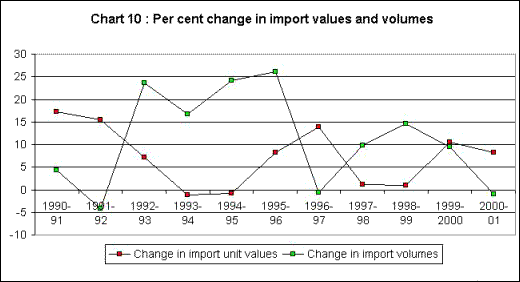It
would also be quite easy to establish – although this
is not brought out through additional data here –
that there is no relationship between the fiscal stance
and inflation rates. Thus, inflation has declined
even though the government's fiscal balance remains
at approximately the same level as a proportion of
GDP.
Instead of monetary factors, which are clearly irrelevant,
what appears to have been more important is a combination
of domestic and external forces in the real economy,
which are increasingly intertwined now with the greater
integration of India with the global economy. The
opening up of the Indian economy coincided in the
latter half of the decade of the 1990s, with a period
of slowdown and recession in international markets.
Since 1996, world trade prices and values of major
commodity groups has slumped and even declined in
some periods. Indeed, deflation is now the order of
the day in the most important large economies of the
world, including Japan for some time past and even,
at present, the United States. This international
slowdown has been accompanied by much greater competitive
pressure and attempts at explicit and implicit dumping,
as producers across the world seek to establish a
foothold in what may become a major future market.
Thus unit values of imports have tended to fall, as
evident in Chart 10. It is also clear that unit values
of imports and import volumes are strongly negatively
correlated, and that lower import prices have been
associated with strong inflows of imports in volume
terms.

Chart
10 >>
Click to Enlarge
This international tendency has been coterminous with
the increasing liberalisation of external trade, which
has affected the domestic price of imported goods
and their substitutes. The removal of quantitative
restrictions and the gradual lowering of tariff barriers
have meant that the price of imported goods has fallen
much more sharply within the domestic economy than
is reflected by simply the unit values of c.i.f. imports.
Obviously, this implies a significant downward pressure
on domestic prices, which helps to explain why prices
of most manufactured goods have remained low or fallen
relative to other prices, despite increases in costs.
Import penetration, along with the lack of a positive
stimulus coming from public investment, shifts in
income distribution and a number of other factors,
have all been associated with domestic recession.
In fact, some degree of de-industrialisation is also
evident, especially among small scale producers who
have been unable to meet the threat of competition
from abroad. Not only does such import competition
tend to have much greater advertising and marketing
power and established brand images, but it is increasingly
coming in at lower per unit prices, as explained above.
So the sheer possibility of import penetration itself,
would have contributed to the control of prices directly
through greater import volumes at lower prices, and
indirectly its effect on domestic recession.
The recession has indeed been probably the most significant
factor behind the current slowdown in prices. While
there are many indicators of this current recession
(including stagnation in industrial output growth,
appalling rates of employment generation, falling
per capita consumption in many rural areas, etc.)
one useful indicator is the strength of capital formation.
Chart 11 shows that real changes in gross and net
domestic capital formation have been quite volatile
over this period, but there is definite evidence of
slowdown in the latter half.

Chart
11 >>
Click to Enlarge
This becomes much more clear from Chart 12, where
the average rates of increase are provided over the
two sub-periods. The rate of change of net capital
formation in real terms has fallen (in terms of annual
averages) very sharply from nearly 10 per cent in
the first sub-period, to just above 5 per cent in
the second.

Chart
12 >>
Click to Enlarge
All these indicators therefore suggest that the dominant
cause of the decline in inflation rates has been the
slowdown in the real economy, combined with the effect
of cheaper imports at a time when internationally
as well, prices are stagnant or falling. This is a
situation as perilously close to deflation as it is
possible to get.
Of course deflation has been largely unknown in India
over its post-Independence history, and so there is
little experience which can be sifted to provide instruction
about how to deal with such a potential situation.
What is clear, however, is that the current very low
rate of inflation is not therefore a cause for celebration,
but much more a source of concern. In addition, it
is likely that this reflects shifts in income distribution
which are more inequalising as well.
What is required in this context is much more active
intervention by the government, in terms of increased
productive spending, to lift the economy out of recession.
A small increase in the price level as a result of
this could even be welcome it is associated with more
growth and employment generation in the system.

